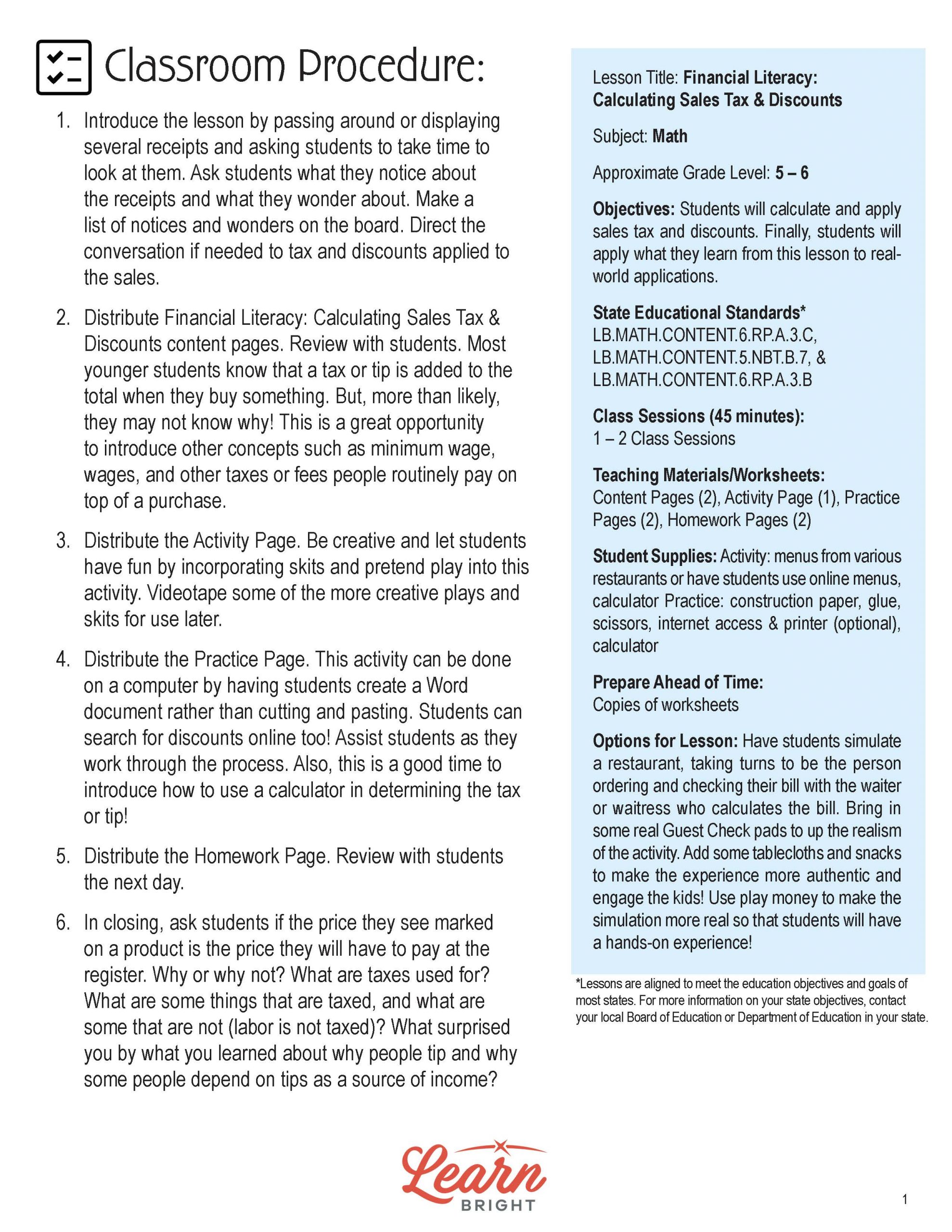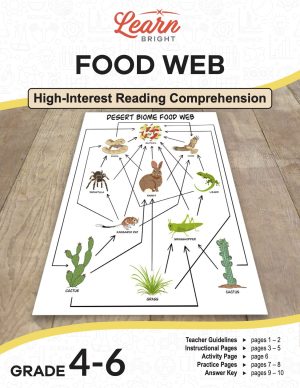Description
What our Financial Literacy: Calculating Sales Tax and Discounts lesson plan includes
Lesson Objectives and Overview: Financial Literacy: Calculating Sales Tax and Discounts teaches students about sales tax and discounts and how to calculate them. At the end of the lesson, students will be able to calculate and apply sales tax and discounts. They will also learn to apply what they learn from this lesson to real world applications. This lesson is for students in 5th grade and 6th grade.
Classroom Procedure
Every lesson plan provides you with a classroom procedure page that outlines a step-by-step guide to follow. You do not have to follow the guide exactly. The guide helps you organize the lesson and details when to hand out worksheets. It also lists information in the blue box that you might find useful. You will find the lesson objectives, state standards, and number of class sessions the lesson should take to complete in this area. In addition, it describes the supplies you will need as well as what and how you need to prepare beforehand. The supplies you will need for this lesson are menus from restaurants, calculators, construction paper, glue, and scissors.
Options for Lesson
Included with this lesson is an “Options for Lesson” section that lists a number of suggestions for activities to add to the lesson or substitutions for the ones already in the lesson. The only optional addition to this lesson is to have students simulate a restaurant, taking turns ordering and checking their bill with the waiter or waitress who calculates the bill. You can also bring in some real Guest Check pads to up the realism of the activity. Add some tablecloths and snacks to make the experience more authentic and engage the kids and use play money to make the simulation more real so that students will have a hands-on experience.
Teacher Notes
The teacher notes page includes a paragraph with additional guidelines and things to think about as you begin to plan your lesson. This page also includes lines that you can use to add your own notes as you’re preparing for this lesson.
FINANCIAL LITERACY: CALCULATING SALES TAX AND DISCOUNTS LESSON PLAN CONTENT PAGES
Financial Literacy: Calculating Sales Tax & Discounts
The Financial Literacy: Calculating Sales Tax and Discounts lesson plan includes three content pages. The lesson begins by asking students to imagine that they’re at the mall with their mom and have $20 to spend. You might find a game you want with a price of $19.99. However, you don’t actually have enough money to buy it because of something called sales tax.
Sales tax is a tax that charged when you buy a good or service. The seller collects that tax and later gives it to the government. The government then uses these taxes to pay for public goods like roads, teachers, water lines, and more.
You calculate sales tax as a percent of the purchase price. You do this by multiplying the cost of the item or service by the sales tax rate. This rate changes depending on the state that you live in and what item you’re buying. Some local governments charge an additional sales tax in addition to the state sales tax. Your state’s sales tax might be 5% and your local sales tax might be 1.5%, so you would pay 6.5% total. Most sales taxes range from 4% to 9%. Some items don’t have sales tax added at all, like groceries and prescription medication.
The lesson then includes a worksheet. On this worksheet, students will write down the tax rate where they live, if groceries are taxed where they live, what part of the tax is local and what is state, and why they think some states have a tax holiday around when school starts.
How Do I Calculate Sales Tax?
The next part of the lesson teaches students how to calculate sales tax. You might want to buy a fidget spinner for $5 at a tax rate of 8.25%. The first step of figuring out how much you owe in total is to change the percent to a decimal. In this case, 8.25% = 0.0825. Next, you multiply the sales price by one plus the decimal. Here, that is 5.00 x 1.0825 = 5.4125. Finally, you round to the nearest hundredth. The final price is $5.41. In this example, sales tax added $0.41 to your purchase!
Other times, you might want to buy something and see a sign that says it’s 20%. We call this a discount. It’s the amount that you take away from the purchase price of a good or service. If you wanted to buy the $5 fidget spinner at a 20% discount, you can calculate how much money you’ll save with the discount. The process is very similar to the process for calculating sales tax. The first step is to change the percent into a decimal. In this case, 20% = 0.2. Next, you multiply the sales price by the decimal: 5.00 x 0.2 = 1. Finally, you subtract that number from the original price: 5 – 1 = 4.
With the discount, the fidget spinner costs $4, but you still have to remember to add sales tax to find the final price! Let’s say the sales tax is 6%. First, change the fraction into a decimal: 6% = 0.06. Next, multiply the discounted price by one plus the decimal: 4.00 x 1.06 = 4.24. The final price is $4.24!
Sales tax doesn’t make a big difference when you buy something small, like a fidget spinner. However, if you make a large or expensive purchase, you might pay a lot of money in sales tax!
FINANCIAL LITERACY: CALCULATING SALES TAX AND DISCOUNTS LESSON PLAN WORKSHEETS
The Financial Literacy: Calculating Sales Tax and Discounts lesson plan includes three worksheets: an activity worksheet, a practice worksheet, and a homework assignment. You can refer to the guide on the classroom procedure page to determine when to hand out each worksheet.
FOOD AND DRINK ORDER ACTIVITY WORKSHEET
For the activity worksheet, students will use the provided menu to fill in four food and drink orders and calculate the total, tax, and final bill for each.
ADVERTISEMENT PRACTICE WORKSHEET
The practice worksheet asks students to find an advertisement that has a discount, print it out, attach it to a piece of construction paper, then write the original price, discount amount as a percentage and decimal, and sale price. Finally, they will add sales tax to find the final price.
CALCULATING SALES TAX AND DISCOUNTS HOMEWORK ASSIGNMENT
For the homework assignment, students will pretend they’re Christmas shopping and will choose a gift for their mom, dad, sibling, and one other person. They will look up the price for each item and will apply the discount shown on the worksheet for each. Next, they will calculate the tax and find the final cost for each item.
Worksheet Answer Keys
This lesson plan includes answer keys for the practice worksheet and the homework assignment. If you choose to administer the lesson pages to your students via PDF, you will need to save a new file that omits these pages. Otherwise, you can simply print out the applicable pages and keep these as reference for yourself when grading assignments.









